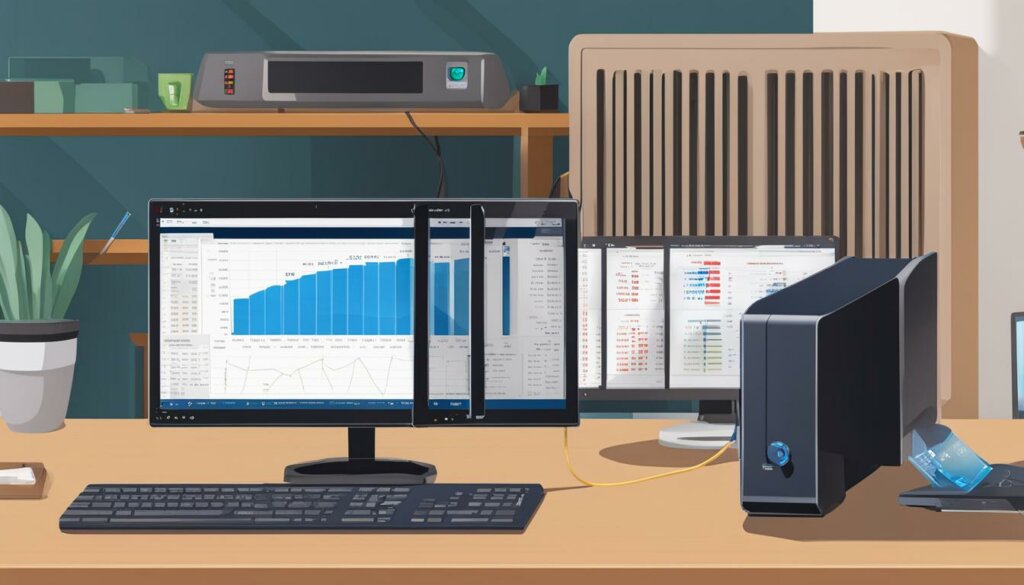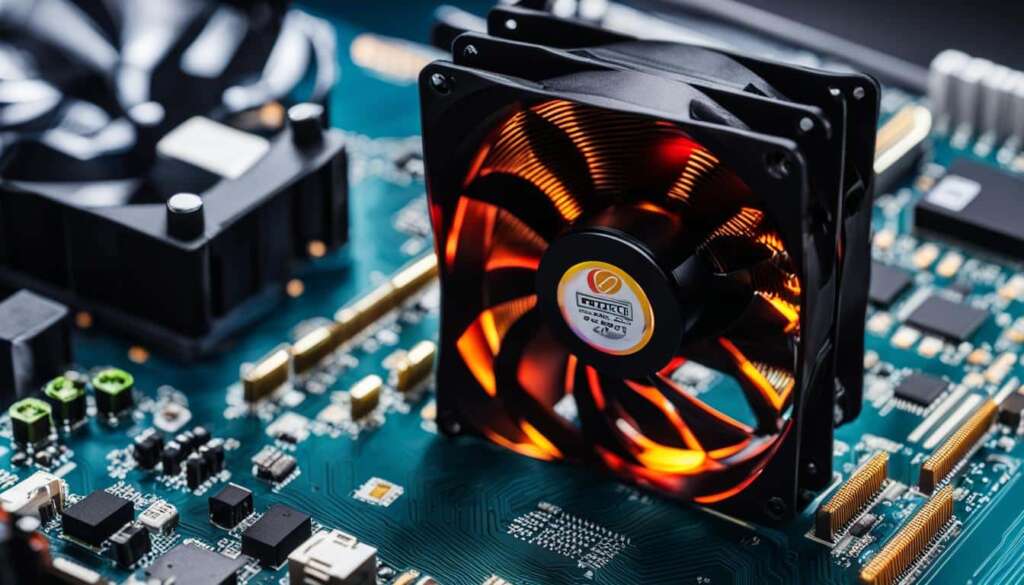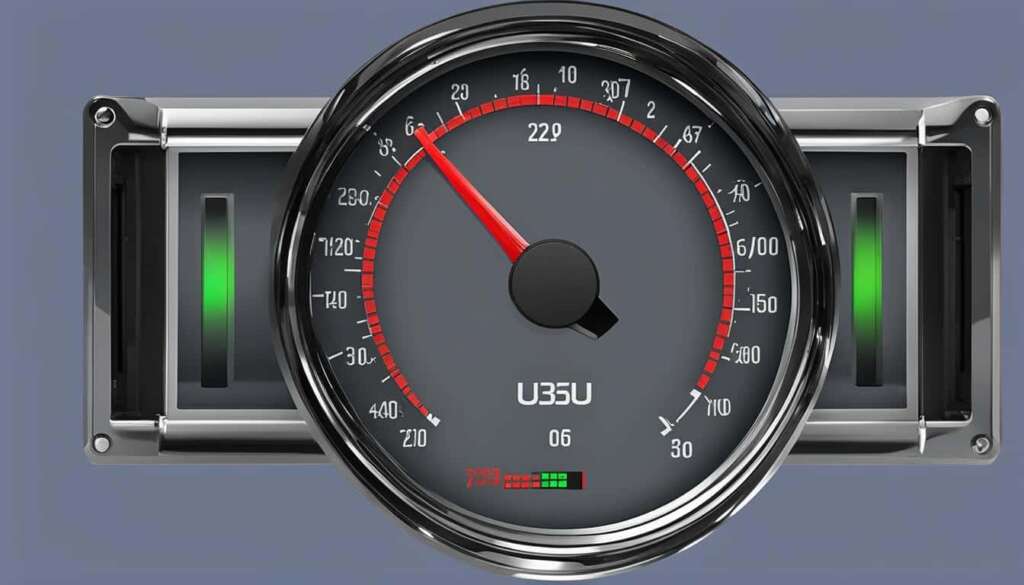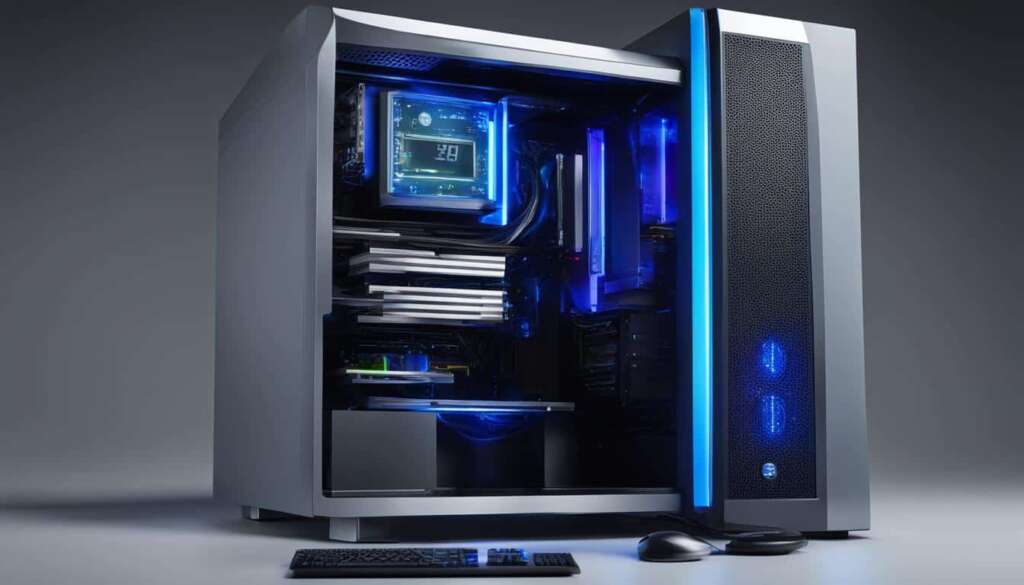Table of Contents
Checking your CPU temperature is crucial for maintaining optimal computer performance and preventing overheating. High CPU temperatures can lead to system instability and long-term damage. To monitor your CPU temperature, you can use various CPU temperature monitoring tools like Core Temp, NZXT’s Cam, HWInfo, Open Hardware Monitor, or SpeedFan. These tools allow you to track the temperature of your CPU cores and monitor any spikes or anomalies in real-time. By regularly checking your CPU temperature, you can ensure that your computer stays within safe temperature ranges and avoid potential issues.
Key Takeaways:
- Monitoring your CPU temperature is crucial for maintaining optimal performance and preventing damage.
- Use CPU temperature monitoring tools like Core Temp, NZXT’s Cam, HWInfo, Open Hardware Monitor, or SpeedFan.
- Regularly check your CPU temperature to ensure it stays within safe ranges and avoid potential issues.
- High CPU temperatures can lead to system instability and long-term damage.
- Take necessary actions if abnormal spikes or temperatures are detected.
Why is my CPU temp so high?
High CPU temperatures can be concerning as they can lead to system instability, crashes, and even permanent damage. Understanding the causes of high CPU temps is essential for troubleshooting and addressing the issue effectively. Here are some common factors that contribute to elevated CPU temperatures:
- Running intensive tasks simultaneously: When your computer is running multiple resource-heavy applications or tasks, it puts a significant load on the CPU, resulting in increased temperatures.
- Overclocking the CPU: Overclocking involves increasing the clock speed of your CPU beyond its factory settings. While it can enhance performance, it also generates more heat, leading to high CPU temperatures.
- Faulty fan: A malfunctioning or damaged CPU fan may not be able to efficiently dissipate heat from the CPU, causing temperatures to rise.
- Dust buildup: Dust accumulation over time can restrict airflow and insulation, preventing proper heat dissipation. This can cause CPUs to overheat.
- Limited ventilation space: If your computer is poorly ventilated or placed in an enclosed space, it can trap heat and result in high CPU temperatures.
To address high CPU temperatures and prevent overheating, you can take the following actions:
- Shut down unnecessary processes: Close any unnecessary applications or background processes that may be placing excessive strain on the CPU.
- Adjust fan speeds: Ensure that your CPU fan is running at an adequate speed to effectively cool the CPU. Some motherboards allow you to adjust fan speeds in the BIOS or through dedicated software.
- Clean out dust buildup: Regularly clean the interior of your computer, especially around the CPU and fans, to remove dust and improve airflow.
- Ensure proper ventilation: Make sure your computer has sufficient airflow and is not placed in a confined space. Positioning your computer in a well-ventilated area can help dissipate heat more effectively.
If you have tried these troubleshooting steps and high CPU temperatures persist, it may be advisable to seek professional assistance or consider upgrading your cooling system.
Understanding the causes of high CPU temperatures is vital for maintaining optimal computer performance and preventing overheating. By identifying and addressing the underlying factors contributing to high CPU temps, you can ensure the longevity and stability of your system.
What CPU temperature is normal?
The normal CPU temperature range can vary depending on the specific CPU model and workload. In general, temperatures between 40-65°C (104-149°F) are considered safe for normal computer use. However, under more intensive tasks or gaming, the CPU temperature can increase to 70-80°C (158-176°F). It’s essential to keep an eye on your CPU temperatures and ensure they stay within these ranges to maintain optimal performance and prevent overheating.
If your CPU consistently reaches temperatures above 80-85°C (176-185°F), it may indicate a problem that requires further investigation and troubleshooting.
Safe CPU Temperature Ranges
| CPU Usage | Temperature Range (°C) | Temperature Range (°F) |
|---|---|---|
| Normal Computer Use | 40-65 | 104-149 |
| Intensive Tasks or Gaming | 70-80 | 158-176 |
Monitoring your CPU temperature and ensuring it stays within safe limits is crucial for preventing system instability and potential damage. Excessive heat can lead to performance issues, crashes, and even hardware failure.
Keeping your CPU temperature in check is essential for maintaining optimal computer performance and preventing overheating. By monitoring temperature readings and taking necessary precautions, you can ensure that your CPU operates within safe temperature ranges, extending its lifespan and preventing potential issues.
How to Check CPU Temp Without BIOS
The BIOS is not the ideal method for continuously monitoring CPU temperatures while using your computer. To check your CPU temperature without accessing the BIOS, you can use third-party software like Core Temp, NZXT’s Cam, HWInfo, Open Hardware Monitor, SpeedFan, or AMD System Monitoring. These software tools provide real-time temperature readings for your CPU and allow you to monitor temperatures while performing various tasks. Download and install the software that suits your needs and preferences, and ensure that you regularly check your CPU temperature to prevent any potential issues.
Third-party software offers a convenient and reliable alternative to checking CPU temperatures without the need to disrupt your workflow by accessing the BIOS. These tools provide accurate and up-to-date temperature readings, allowing you to monitor the performance and temperature of your CPU in real-time.
Benefits of Third-Party CPU Temperature Monitoring Software
- Real-time temperature monitoring: Third-party software provides instantaneous CPU temperature readings, allowing you to keep an eye on your CPU’s performance while running various applications and tasks.
- User-friendly interface: These software tools offer intuitive interfaces that are easy to navigate, making it simple for both beginners and advanced users to access and understand CPU temperature data.
- Customizable alerts and notifications: You can set up custom alerts and notifications within the software to receive warnings when your CPU temperature exceeds certain thresholds, ensuring you can take immediate action to prevent overheating.
- Historical temperature data: Many third-party software solutions offer the ability to track and store CPU temperature data over time, allowing you to analyze trends and identify any temperature-related issues.
With third-party software for CPU temperature monitoring, you can easily and accurately keep track of your CPU’s temperature without the need to access the BIOS. Regularly checking your CPU temperature is crucial for maintaining optimal performance and preventing overheating-related issues that can lead to system instability and damage.

By using reliable third-party software tools, you can ensure that your CPU stays within safe temperature ranges and take necessary measures to address any abnormalities or potential overheating problems.
How to Monitor CPU Temperature Constantly
When it comes to monitoring your CPU temperature constantly, there are tools available that offer features to help you keep a close eye on your system’s temperature levels. One such tool is Core Temp, which provides real-time temperature readings and allows you to display them at all times. To make the CPU temperature monitor visible in your taskbar, resembling a mini thermometer or CPU temperature gauge, follow these simple steps:
- Download and install Core Temp from the official website.
- Launch Core Temp on your computer.
- In the Core Temp window, navigate to the “Options” menu.
- From the dropdown menu, select “Settings”.
- In the “Settings” window, go to the “System Tray” tab.
- Check the box that says “Display the temperature on the Windows taskbar”.
- Customize the appearance of the temperature display with various options like font size, color, and units (Celsius or Fahrenheit).
- Click “OK” to save your changes.
Once you’ve pinned the CPU temperature readings to your taskbar, you’ll be able to monitor them constantly. This feature is particularly useful when working with demanding applications or in high-temperature environments, as it allows you to quickly spot any abnormalities or spikes in temperature. By keeping a constant eye on your CPU temperature, you can ensure that it stays within safe limits and take necessary actions if needed.
If you prefer an alternative to Core Temp, there are other CPU temperature monitoring tools available that offer similar features. Make sure to find the one that suits your needs and preferences in terms of functionality and user interface.
Advanced Monitoring Options
In addition to displaying the CPU temperature in your taskbar, some monitoring tools offer a range of advanced options to enhance your monitoring experience. For example, you can set up notifications to alert you when the temperature exceeds a certain threshold or use configurable widgets to display temperature information directly on your desktop. These options provide even more flexibility and convenience when it comes to monitoring your CPU temperature constantly.
Remember, monitoring your CPU temperature is crucial for maintaining optimal computer performance and preventing overheating. By using tools like Core Temp or other CPU temperature monitoring software, you can ensure that your computer stays within safe temperature ranges, preventing potential issues and maximizing system longevity.
Conclusion
Monitoring your CPU temperature is crucial for maintaining optimal computer performance and preventing overheating. By regularly checking your CPU temperature using tools like Core Temp or other CPU temperature monitoring software, you can ensure that your computer stays within safe temperature ranges and avoid potential issues. High CPU temperatures can lead to system instability, crashes, and long-term damage if not addressed.
Additionally, understanding the causes of high CPU temperatures and taking necessary precautions such as proper cooling, dust removal, and ensuring good airflow can help prevent overheating issues. Regularly monitoring your CPU temperature and taking appropriate actions to address any abnormalities will keep your computer running smoothly and efficiently.
To maintain optimal computer performance, it is essential to prioritize CPU temperature monitoring. By doing so, you can proactively prevent overheating-related problems and extend the lifespan of your computer. Remember to check your CPU temperature using reliable monitoring software and implement necessary cooling solutions to ensure your computer’s longevity and optimal performance.
FAQ
How can I check my CPU temperature?
You can use various CPU temperature monitoring tools like Core Temp, NZXT’s Cam, HWInfo, Open Hardware Monitor, or SpeedFan to check your CPU temperature.
Why is my CPU temperature so high?
Several factors can contribute to high CPU temperatures, including running intensive tasks simultaneously, overclocking the CPU, having a faulty fan, dust buildup, or limited ventilation space.
What is the normal range for CPU temperatures?
The normal CPU temperature range can vary depending on the specific CPU model and workload. In general, temperatures between 40-65°C (104-149°F) are considered safe for normal computer use, and under more intensive tasks or gaming, the CPU temperature can increase to 70-80°C (158-176°F).
How can I check my CPU temperature without accessing the BIOS?
You can use third-party software like Core Temp, NZXT’s Cam, HWInfo, Open Hardware Monitor, SpeedFan, or AMD System Monitoring to check your CPU temperature without accessing the BIOS.
How can I monitor my CPU temperature constantly?
You can use tools like Core Temp that offer features to display temperature readings constantly. Core Temp allows you to pin the CPU temperature readings to your taskbar, so you can monitor them at all times.
Why is monitoring CPU temperature important?
Monitoring your CPU temperature is essential for maintaining optimal computer performance and preventing overheating. High CPU temperatures can lead to system instability, crashes, and long-term damage if not addressed.







